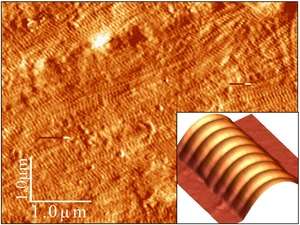Nanobiomechanics
Nanobiomechanics (also bionanomechanics) is an emerging field in nanoscience and biomechanics that combines the powerful tools of nanomechanics to explore fundamental science of biomaterials and biomechanics.

Since the introduction by its founder Yuan-Cheng Fung, the field of biomechanics has become one of the branches of mechanics and bioscience. For many years, biomechanics has examined tissue. Through advancements in nanoscience, the scale of the forces that could be measured and also the scale of observation of biomaterials was reduced to "nano" and "pico" level. Consequently, it became possible to measure the mechanical properties of biological materials at nanoscale.
Most of the biological materials have different hierarchical levels, and the smallest ones refer to the nanoscale. For example, bone has up to seven levels of biological organization, and the smallest level, i.e., single collagen fibril and hydroxylapatite minerals have dimensions well below 100 nm. Therefore, being able to probe properties at this small scales provides a great opportunity for better understanding the fundamental properties of these materials. For example, measurements have shown that nanomechanical heterogeneity exists even within single collagen fibrils as small as 100 nm.[1]
One of the other most relevant topics in this field is measurement of tiny forces on living cells to recognize changes caused by different diseases. For example, it has been shown that red blood cells infected by malaria are 10 times stiffer than normal cells.[2] Likewise, it has been shown that cancer cells are 70 percent softer than normal cells.[3] Early signs of aging cartilage and osteoarthritis has been shown by looking at the changes in the tissue at the nanoscale.[4]
Methods and instrumentation
The common methods in nanobiomechanics are atomic force microscope, optical tweezers, and magnetic twisting cytometry.
Examples of relevant materials are bone[5] and its hierarchical constituents such as single collagen fibrils, single living cells, actin filaments and microtubules,[6] and synthetic peptide nanotubes.
Computational nanobiomechanics
In addition to experimental aspect, research has been expanding through computational methods. Molecular dynamics (MD) simulations have provided a wealth of knowledge in this area. Although, the MD simulation are still limited to a small number of atoms and molecules, due to limitation in the computational performance, they have proved to be an instrumental branch of this emerging field.
References
- Minary-Jolandan, Majid; Yu, Min-Feng (2009). "Nanomechanical heterogeneity in the gap and overlap regions of type I collagen fibrils with implications for bone heterogeneity". Biomacromolecules. 10 (9): 2565–70. doi:10.1021/bm900519v. PMID 19694448.
- Michael Fitzgerald (March–April 2006). "Nanobiomechanics". Technology Review. MIT. Retrieved February 23, 2011.
- Katherine Bourzac (December 4, 2007). "The Feel of Cancer Cells". Technology Review. MIT. Retrieved February 23, 2011.
- Stolz M, Gottardi R, Raiteri R, Miot S, Martin I, Imer R, et al. (2009). "Early detection of aging cartilage and osteoarthritis in mice and patient samples using atomic force microscopy". Nature Nanotechnology. 4 (3): 186–92. doi:10.1038/nnano.2008.410. PMID 19265849.
- Tai K, Dao M, Suresh S, Palazoglu A, Ortiz C (2007). "Nanoscale heterogeneity promotes energy dissipation in bone" (PDF). Nature Materials. 6 (6): 454–62. doi:10.1038/nmat1911. PMID 17515917. Archived from the original (PDF) on April 22, 2012.
- Kiss; et al. (2002). "Nanomechanics of Microtubules" (PDF). Physical Review Letters. 89 (24): 248101. doi:10.1103/PhysRevLett.89.248101. PMID 12484982.